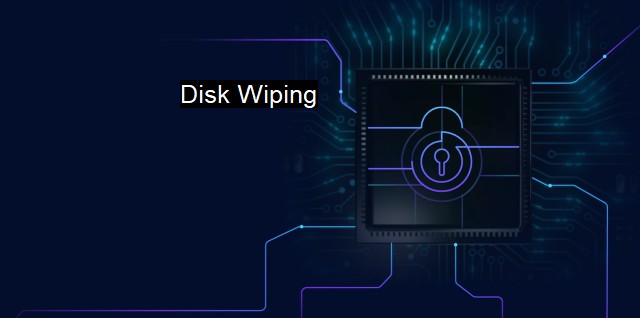What is Disk Wiping?
The Importance of Disk Wiping in Cybersecurity: Explained, Types, and Implementation
Disk wiping is a mechanism primarily designed to ensure that the data on a computer disk is permanently deleted or erased, offering the users additional layer of security. This process is generally utilized when the said disk is to be dumped, recycled, or reused. A secure disk-wipe fundamentally demolishes all data stored on a disk, rendering it virtually irretrievable.This practice is essential because simply deleting your files doesn’t mean they are gone permanently. A standard file deletion operation only discards file headers, which are the components that keep the file's metadata the computer requires locating and opening them. The actual contents of the file remain intact and recoverable until the space is overwritten by other data. This is where disk wiping comes into play. It is thoroughly employed to overwrite disk-space with random, garbled data which further means no method or software can retrieve any file or information that previously concentrated on the disk.
Disk wiping takes a step beyond standard deletion procedures. When a file is ‘deleted’ in the conventional sense, the data isn’t immediately destroyed. The system merely marks the area previously occupied by the file as ‘unused’, making it readily available for other files or programs. In reality, until the data is overwritten entirely, often by means of disk wiping, it's possible for individuals with the correct expertise and software to restore the file.
Given our current era of sharp technological advancements, steep rise in incidents attributable to data leaks, hacks, and threats, securing all elements of one's digital life should be a priority. Important consideration should be given to the data residing on physical storage devices, especially when discarding or selling used machines or prying into second-hand units. Just as you wouldn't leave paperwork with sensitive information lying around for anyone to find, virtual pieces of data should be treated similarly – even when no longer wanted or valuable in your eyes.
There are technical differences between fully secure and straightforward deletion procedures. Disk wiping employs its methods to rewrite the hard drive with random bytes, zero (null) bytes, or specified patterns, forcing physical overwrite on the disk sectors, fully destroying the existing information. This serves to chuck out possibilities for data reconstruction or abuse.
Several useful tools are available for this purpose, these largely conform to three standards: the U.S. Department of Defense's DoD 5220.22-M, the National Institute of Standards and Technology's NIST 800-88, and the German Federal Office for Information Security's VSITR. These tools provide you the assurance that wiped data can't be resurrected via software or hardware data recovery methods.
While it’s commonplace to focus on virtual security measures, like having robust passwords or employing the latest antivirus software, it's imperative to also consider the physical devices. Good cybersecurity practices include understanding that digital discarded data, when not properly managed, can fall into the wrong hands, leading to leakages of sensitive information. Thus, the systematic use of disk wiping helps in annihilating secure data traces which significantly reduces potential vulnerabilities and cyber threats.
Equally important to consider in the cybersecurity structure planning are how, when, and where the data will be discarded. It’s crucial to have a well-structured disposal procedure installed within the company. This not only reduces the possibility of data leakages but also ensures that no stone is left unturned or no outdated device is left filled with recoverable, sensitive data.
Disk wiping plays a significant role within cybersecurity and antivirus frameworks. Proper data management and disposal procedures do not entirely stop at files being moved to the recycle bin and then emptied out. Rather, the necessary steps should be taken to ensure erased data is securely wiped off, either through employing reliable disk wiping software, or having clear internal protocol for safe, systematic data disposal. Companies and individuals ought to uphold rigorous data management routines and utilize effective disk wiping tactics to mitigate eventual data vulnerabilities and subsequent cyber threats.

Disk Wiping FAQs
What is disk wiping?
Disk wiping is the process of completely erasing all data from a storage device, making it impossible to recover any information from that device.Why is disk wiping important in cybersecurity?
Disk wiping is essential in cybersecurity because it ensures that sensitive or confidential information is not accessible to unauthorized individuals, even if the device is disposed of or recycled.Can antivirus software perform disk wiping?
Some antivirus software comes with built-in disk wiping capabilities. However, for greater security and to comply with regulations and standards, it may be necessary to use specialized disk wiping tools.Is disk wiping permanent?
Disk wiping is considered permanent unless the device is physically damaged, making it impossible to access the data. It is important to note that proper disk wiping techniques should be used to ensure that all data is completely erased and cannot be recovered.| | A | | | B | | | C | | | D | | | E | | | F | | | G | | | H | | | I | | | J | | | K | | | L | | | M | |
| | N | | | O | | | P | | | Q | | | R | | | S | | | T | | | U | | | V | | | W | | | X | | | Y | | | Z | |
| | 1 | | | 2 | | | 3 | | | 4 | | | 7 | | | 8 | | |||||||